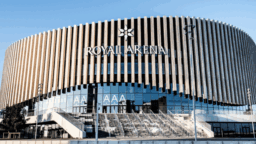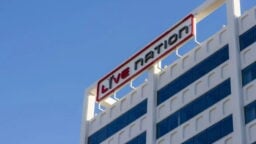The era of “all-in” pricing for concert tickets is finally arriving in the United States – and it will be backed by the law, Live Nation’s leadership predicts.
The live concert and ticketing company announced its Q4 2023 and full-year earnings on Friday (February 23), showing revenues up a whopping 36% YoY in 2023, to USD $22.7 billion.
Its ticketing business, Ticketmaster, saw revenues spike by 32% YoY, on a constant currency basis, to $2.9 billion. All told, the company’s adjusted operating income jumped 32% YoY, to $1.86 billion.
Little wonder, then, that the company called 2023 its “biggest year ever.”
Even some bets that seemed potentially shaky paid off – not least Live Nation’s shift to all-in pricing at its owned-and-operated festivals and venues in the US last September.
Concertgoers have long complained about the “bait-and-switch” nature of advertised ticket prices. After fees, taxes and other add-ons, tickets could sometimes cost considerably more than the posted amount. It was in response to these types of criticisms that Live Nation announced its new US-wide policy last year.
And despite some reservations about a policy that would mean Live Nation would be advertising relatively higher ticket prices than competing sellers, the company reported on Friday that they were seeing no negative impact, and even actually seeing a higher conversion rate (i.e., more people clicking through from the advertised price to ticket purchase).
“We’re actually surprised and thrilled because we were always skeptical if we [could] be the one to lead the path, if there was any [reduction in] conversion that would hurt us. But I think consumers are loving the idea [that] they can see [the final price] up front,” CEO Michael Rapino said on Live Nation’s earnings call Friday.
“Ultimately, they’re shopping multiple tabs anyway, so they’re probably figuring out the true costs are the same. So yeah, we think it’s a great test.”
Rapino also predicted that all-in pricing, in some way, will eventually become not just a matter of practice for ticket sellers, but also a matter of law.
“I think consumers are loving the idea [that] they can see [the final price] up front.”
Michael Rapino, Live Nation
He said that in talks with politicians, “this seems to be the common torch that everyone’s running with. So I would assume this ends up being legislated somewhere, over time, and I would assume others are going to start jumping on the all-in wagon as a good step forward for consumers, so we can worry about the other issues around scalping, etc.,” Rapino added.
Indeed, three US states have already mandated all-in pricing, with Ticketmaster already offering all-in ticket prices in New York, Tennessee and Connecticut.
And there’s a good chance that a similar law could be passed on the national level. The Speculative Ticketing Oversight and Prohibition (STOP) Act got the green light from a House of Representatives committee in December, making it eligible for a full House vote.
Here are three other things we learned on Live Nation’s latest earnings call…
1) Dynamic pricing is Live Nation’s ‘great growth opportunity’ as it expands internationally
Live Nation’s Platinum program – the name the company gives to its “dynamic” ticket pricing strategy – has seen some controversies over the past few years, not least when high demand for a particular show results in elevated prices for the best seats in the house, as was the case with Bruce Springsteen’s tour.
The company defends the program on the grounds that, without dynamic pricing, the difference between what it charges for tickets and the highest prices fans are willing to pay ends up in the hands of secondary-market ticket sellers, i.e. scalpers, rather than in artists’ hands.
Live Nation also argues that dynamic pricing effectively subsidizes the lower-priced tickets at the back of the house.
Despite the pushback from some fans, the company is pushing forward with its plans to expand dynamic pricing – especially in markets outside the US, where the practice has just begun.
“Outside of the US, we’re in the first inning… We’re just rolling this out around the world. So that’s the great growth opportunity, obviously,” Rapino said on the earnings call.
“We’ve had it in Europe but [it’s] still in [its] infancy stages. We’re going to expand it down to South America, Australia, etc.”
“Outside of the US, we’re in the first inning… We’re just rolling this out around the world. So that’s the great growth opportunity, obviously.”
Live Nation’s Michael Rapino, on dynamic pricing
He says when Live Nation brings the practice to international markets, it’s “well received when it gets there. Promoters are anxious for it. Artists are anxious for it, because they see, when they sell an arena in Baltimore versus Milan right now, they look at the grosses and say, ‘Wow, we’re leaving too much on the table for the scalpers. Let’s price this better.’ So that’s our best sales pitch. So you’re going to see that [accelerate].”
In the US, dynamic pricing is “in the fifth inning,” Rapino said, implying that its implementation is roughly half-finished. He added he expects to see it expanded from top-tier artists’ shows to lower-tier venues such as amphitheaters and smaller venues.
“So we still think that’s a multiyear opportunity to continue to grow our top line/bottom line,” he said.
2) Live Nation sees demand shifting from stadiums to amphitheaters this year – but that’s good for margins
In 2023, stadium shows led Live Nation’s attendance growth, with more than 29 million fans attending stadium shows, an increase of 60% YoY.
But that was the year of Taylor Swift, Morgan Wallen and Bruce Springsteen. This coming year may look somewhat different, especially given the high baseline set by 2023.
Though Live Nation still sees a strong year for stadium shows – on the call, Rapino mentioned planned tours by Usher, Justin Timberlake and Jennifer Lopez – yet it also sees a shift in demand away from the largest venues towards amphitheaters, and lower volume overall in stadiums.
That will have an effect on Live Nation’s deferred revenue (since the timeline for ticket sales at amphitheaters is shorter than the timeline on sales for stadium concerts) and it will mean more of Live Nation’s concert revenue concentrated in Q2 and Q3 this year (since the bulk of amphitheater shows take place in the warmer months in and around summer).
“[At amphitheaters] when we invest capital on-site, we’re getting 20%, 30% returns on capital when we turn that grassy area into a VIP club, a membership club.”
Michael Rapino, Live Nation
Yet for Live Nation, this means higher margins, because – unlike with many stadium shows – the company owns its own network of amphitheaters.
“It’s going to have a higher AOI [adjusted operating income] per fan because we’re counting the beer money, the parking money, other revenue streams when we have the fans on-site,” Live Nation President and CFO Joe Berchtold said on the call.
“It will mean, just on a top-line basis, a lower revenue per fan because the stadium tickets tend to be the highest priced tickets, so you’ll see a real divergence there between the AOI per fan and the revenue per fan,” Berchtold continued.
“That obviously will translate into improved margin on the concert segment this year, which should particularly come through in the second and third quarters. On Ticketmaster, the way it flows through is that it would have had fewer on-sales in the fourth quarter because the amphitheater shows tend to go on sale closer in time to the shows.”
One explanation for this shift towards amphitheater shows is the boom in “middle class” artists, those touring musicians who are not quite at the level of stadium shows, but with a larger fan base than those who tour clubs.
Live Nation’s leadership also noted that investments into premium offerings at owned-and-operated amphitheaters also present a large profit opportunity.
At the amphitheaters, “when we invest capital on-site, we’re getting 20%, 30% returns on capital when we turn that grassy area into a VIP club, a membership club,” Rapino said, adding that amphitheaters “could double their AOI” if Live Nation focuses on how to upscale these sites with premium experiences.
3) Live Nation plans to spend $300 million on new venues and renos this year
Speaking of upscaling, Live Nation is planning to spend $300 million in 2024 on new venues and renovations to its existing stock.
“And about half of that, about $150 million, is our top four projects, [which] would include a major revamp of Foro Sol, which is the top international stadium in the world, down in Mexico City,” Berchtold said on the call.
He added that these projects have an expected return on investment in the mid-20s percent.
“The other [revenue generator] would be a combination of tactical things in existing venues. A new VIP club, a new viewing deck, rock boxes, some new bar designs that are extremely high returns, generally, 40s, 50s-plus percent,” Berchtold added.
In the longer term, venue acquisitions will continue, Rapino said.
Live Nation is “winning right now some key venues around the world that we’ll be continuing to announce,” he told analysts on the call.
“So we see it scaling over the next five years much, much higher than it was in the past, just because we hadn’t focused that much on international arenas before, and we see a great path forward on these.”Music Business Worldwide





